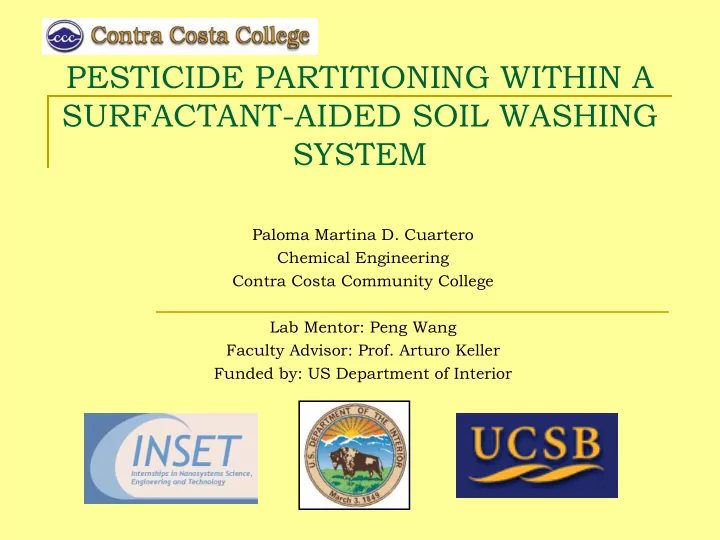

PESTICIDE PARTITIONING WITHIN A SURFACTANT-AIDED SOIL WASHING SYSTEM Paloma Martina D. Cuartero Chemical Engineering Contra Costa Community College Lab Mentor: Peng Wang Faculty Advisor: Prof. Arturo Keller Funded by: US Department of Interior
BACKGROUND � Pesticide Contamination � Surfactants Surfactants in water/soil system is present as: � Monomers; � Micelles, which are aggregates of the monomers and form when the monomer concentration reaches the Critical Micelle Concentration (CMC) value; � Sorbed surfactants in the soil particles Monomer Conc. = CMC Monomer Micelle
OBJECTIVE � To investigate pesticide partitioning behavior within a surfactant-aided soil washing system. WHAT WE DID… � Study the sorption behaviors of pesticides and surfactants onto soil particles; � Study the pesticide sorption in the presence of surfactants; � Investigate the effect of surfactants on desorption of pesticides.
MATERIALS Surfactants � Soil Samples � � Triton (Nonionic) � Agriculture (Ag)#1, Ag#2, � Linear Alkyl Sulfate (LAS) Ag#3 � Sodium Dodecyl Sulfate � Clayey (SDS) (Anionic) � Sediment � Benzalkonium Chloride (BC) (Cationic) � Pesticides � Atrazine � Diuron
METHOD Batch Equilibrium Technique was used to conduct all � sorption and desorption experiment. Procedure: 1. Weigh 2grams of soil 2. Add various amounts of pesticide and surfactant 3. Mix for about 20 hours 4. Centrifuge the samples 5. Analyze the aqueous phase using High Performance Liquid Chromatography High Performance Liquid Chromatography (HPLC)
RESULTS Diuron sorption in the absence of surfactant • Soil organic matter (SOM) Ag#1 and the soil clay content are 60 Ag#2 Sorbed conc (mg/kg) Ag#3 the dominant parameters in Clayey 40 Sediment terms of pesticide sorption. 20 0 0 5 10 15 20 25 Aqueous conc. (mg/l) Triton sorption • The triton sorption shows Ag#1 Ag#2 5.E+04 an increase then starts to Triton sorbed conc. (mg/kg) Ag#3 Clayey level off. Sediment 3.E+04 • BC, LAS, and SDS shows 2.E+04 the same sorption pattern but to a different extent. 0.E+00 0 5 10 15 20 25 Triton aqueous conc (g/l)
Diuron sorption in the presence of Triton (Diuron: 15.95ppm) 16 Diuron aqueous conc. (mg/l) 14 aqueous 12 phase Ag#1 10 Ag#2 8 Ag#3 6 Clayey 4 Sediment 2 0 5 10 15 20 25 sorbed phase Triton aqueous conc. (g/l) • In presence of low concentration surfactants, the concentration of pesticide in the sorbed phase increases.
Diuron sorption in the presence of BC (Diuron conc.: 15.95ppm) Ag#1 Ag#2 14 Diuron aqueous conc. (mg/l) Ag#3 12 Clayey Sediment 10 8 6 4 2 0 0 5 10 15 20 25 BC aqueous equilbrium conc. (g/l) BC, being a cationic surfactant, sorbs more into the soil particles which explains the much lower Diuron aqueous concentration at the first stage.
Diuron desorption in the presence of Triton (2.0267 g/l) Ag#1 60 Ag#2 Ag#3 Diuron sorbed conc. (mg/kg) Clayey Sediment 40 Ag#1 (water) 20 0 0 2 4 6 8 10 12 14 Diuron aqueous conc. (mg/l) Comparing Ag#1 and Ag#1(water), the enhanced desorption happened after cycle #2.
CONCLUSION The presence of surfactant has a significant effect in the � pesticide partitioning within the soil washing system Different surfactants have different potential to enhance � pesticide desorption. This enhancement is surfactant and soil dependent. The enhanced desorption happens only if the surfactant � concentration is higher than a certain value which is also surfactant and soil dependent.
FUTURE PLANS Statistical Analysis on the experimental data to determine � which parameters are dominant in terms of surfactant sorption. Conduct Batch Experiments to investigate the effect of � surfactant on dispersion of soil particles especially of soil colloidal particles (<2µm).
ACKNOWLEDGEMENTS Peng Wang Prof. Arturo Keller Samantha Freeman, Liu-Yen Kramer Dr. Nick Arnold, Andrew Morill, & Evelyn Hu Internships in NanoScience, Engineering and Technology (INSET) California NanoSystems Institute (CNSI) Center for Science Excellence (CSE) University of Santa Barbara (UCSB) Contra Costa College
QUESTIONS?
aqueous phase sorbed phase pesticide soil particle Sorbed surfactant
chemicals hydrophobic less hydrophobic silica particulate
SOIL PROPERTIES Clay Silt Sand Ag#1 11.0% 13.5% 75.5% Ag#2 18.8% 23.4% 57.8% Ag#3 25.5% 16.4% 58.4% Clayey 15.0% 28.2% 56.8% Sediment 3.1% 13.0% 83.9%
Recommend
More recommend